Facts about the WAVES
.
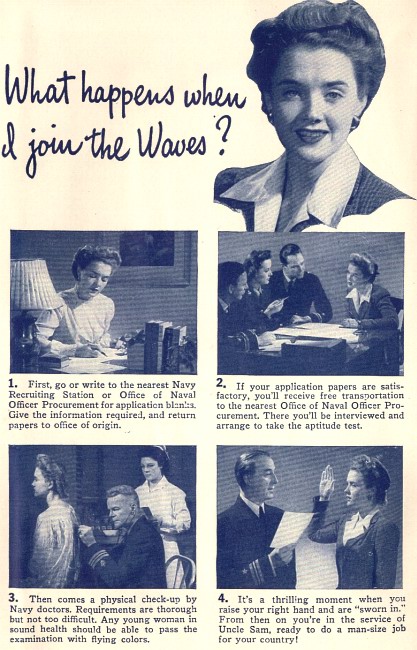 . .
.
Requirements for Joining
.
| . |
Enlisted Women |
WAVE Officers |
| Citizenship |
Native-born American
or, if not native-born, parents
must have naturalization papers |
Same |
| Minimum Age |
18 |
20 |
| Marriage |
Married women were allowed to
enlist, provided their husbands were not in the same branch of service.
Marrying during the training period was not permitted, but afterwards no
marriage restrictions |
Same |
| Dependents |
No children under 18 |
Same |
| Character |
Good character,
3 references |
Must possess qualities of character,
appearance, manner and bearing and capacity of leadership |
| Education |
Two years of high school or
business school |
College degree or two years
of college work plus at least two years of acceptable business or professional
experience.
Two years of mathematics in
high school or college |
| Experience |
Record of occupation since leaving
school |
Same |
| Height |
At least 5 feet |
Same |
| Weight |
At least 95 pounds,
weight in proportion to general
body build |
Same |
| Eyes |
Eyes correctable with glasses
to 20/20 vision |
Minimum Vision in each eye 12/20,
corrected to 20/20 |
| Hearing |
Ability to distinguish whispered
words at 15 feet |
Same |
| Teeth |
Natural teeth in sound condition
or satisfactory replacements |
Minimum of 18 sound teeth, with
at least 2 molars opposing on each side and 4 opposing front teeth |
.
Training
.
During 1942, training was provided for enlisted
WAVES within 16 training schools, as well as the Naval Reserve Midshipmen's
School for officers.
.
WAVES received instruction in various fields
ranging from general duty to gunnery and communications, aviation-related
ground services, navigation and other skills. Large numbers were also trained
in Navy communications. As the job opportunities for WAVES expanded, more
training programs were implemented. |
.... |
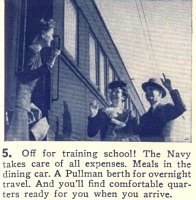
|
.
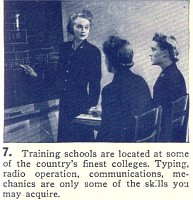 |
..... |
The size of the training program for WAVES
is reflected by the fact that nearly 5,000 women were undergoing training
at any one time throughout the war.
During World War II, over 104,000 women finished
basic and advanced training at over 40 different Navy establishments. Many
of these training courses were given in schools once exclusively reserved
for male sailors. |
.
| Not only was basic training mandated, but
also many advanced courses were made available in such fields as supply,
medical, commissary, administration and communications.
Numerous specialized functions having an aviation-rating
requirement became accessible to female participation, and this resulted
in openings in selected aviation-training courses. These included training
in various specialties, from parachutist rigging to operation of aircraft
control towers. |
......... |
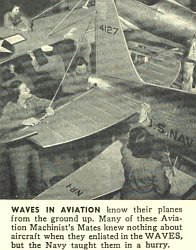 |
.
Training of Enlisted WAVES
Enlisted WAVES initially underwent 4 to 6 weeks
of basic training within the recruit school (Naval Training School). The
first naval training school was established in December 1942 at Iowa State
Teacher's College.
.

U.S. Naval Training Center,
Women's Reserve, at Hunter College campus, The Bronx, New York
|
....... |
During February 1943, this recruit
center was relocated to Hunter College in New York City. The training staff
was composed of 100 officers, of which 70 of were female officers.
Basic training taught the fundamentals of navy
life, drill, discipline and other military essentials to the newly enlisted
WAVES recruits. |
.
| The enlisted WAVES were then either ordered
to a naval base or naval air base for immediate duty, or selected for additional
instruction at advanced schools. There they were taught specific techniques
and skills required for specialized military duties.
The first advanced schools for enlisted WAVES
began operating in October 1942 at the University of Wisconsin (Madison
campus) for communications specialists, the University of Indiana for storekeepers,
and Oklahoma A&M University for yeomen. A total of 16 advanced schools
were active by the end of 1942, and this number expanded to 20 advanced
schools during 1943. |
... |
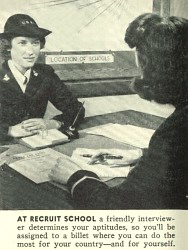 |
.
Typical advanced schooling was located as
follows:
.
| Naval Air Stations |
- Norman (Oklahoma),
- Memphis (Tennessee),
- Atlanta (Georgia),
- Lakehurst (New Jersey) |
| Naval Hospitals |
- Bethesda (Maryland),
- Sand Diego (California) |
| Campuses |
- Indiana University at Bloomington (Indiana),
- Oklahoma Agricultural and Mechanical College
at Stillwater
(Oklahoma),
- University of Wisconsins at Madison (Wisconsins),
- Iowa State Teachers College at Cedar Falls
(Iowa),
- Georgia State College for Women at Milledgeville
(Georgia);
- Miami University at Oxford (Ohio) |
.
Training of WAVE Officers
WAVE officers were sent to the Naval Reserve
Midshipmen’s School, located at Smith College in Northampton, Massachusetts,
to learn the fundamentals of naval leadership. The school was nicknamed
“USS Northampton”, and the officer basic course lasted 2 months.
.
On August 13, 1942, Captain Herbert W, Underwood,
USN (Ret.) assumed the position of Commanding Officer, and the first group
of 125 female officers reported to the school on August 28 as probationary
officers. They had been appointed directly from civilian life as accomplished
business or educational leaders, and most had college degrees.
.
| The regular training program for WAVE officer
candidates was officially initiated on October 6, 1942 at the Naval Reserve
Midshipmen’s School.
The classes began with 900 potential female
officers. The rapid influx of more WAVE officers required expansion of
facilities.
In November, another officer training school
was established at Mount Holyoke College in South Hadley, Massachusetts.
By the end of the World War II, over 10,500
female officers went through Smith and Mount Holyoke Colleges. |
...... |
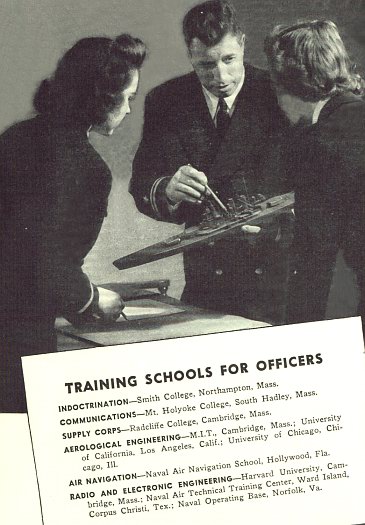 |
.
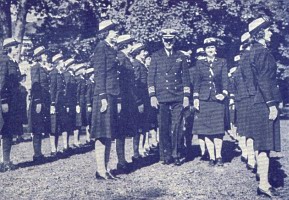 |
........ |
Training of WAVES officers was like that of
male reserve officers. They were taught military drill, physical education,
leadership principles, naval history and tradition, and other subjects
appropriate for understanding Navy organization and administration. |
.
Specialized training for WAVES officers initially
concentrated on the communications field, and 1,700 were trained specifically
Communication Watch Officers. Later women officers learned to be administrators,
language specialists, radio and radar technicians, lawyers and educational
services officers.
About 400 female officers became medical specialists
as laboratory technicians, dental hygienists and occupational and physical
therapists. As the aviation field opened up for WAVE officers, many underwent
specialized training in various air-related activities. They were trained
to be aerologists, air-transport officers, link celestial navigation
instructors and air navigators. The female air navigators were the first
women who performed duties as part of a military aircrew, and were
graduated with Naval Aviator Air Navigator wings.
.
.
[
I. Development ] [ II. Facts
about the WAVES ] [
III. Uniforms ] [ IV. Sources ]
|
 .
.
